Inclusive Playground Design for Everyone
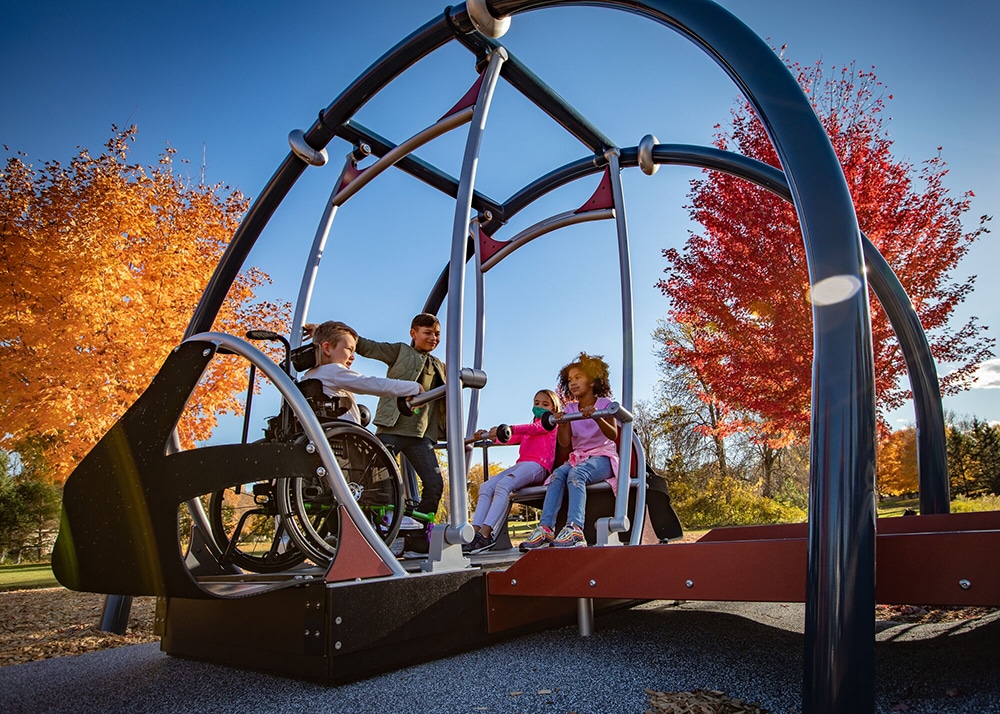
Written by Sonya Wilson
At its heart, inclusivity is about belonging. It is about a family visit to the park where Gran sits on a bench close to the playground, in the shade of a tree, to watch her grandkids having fun. Her daughter, zipping by in her wheelchair across the rubber surfacing, catches her youngest grandchild, who is bumping down the roller slide with another little girl. The girls giggle at how the rollers make their legs wobble and their voices warble. Watching her daughter whisk the little girl over to the drinking fountain, she is glad to see that it has been constructed with wheelchair users in mind.
Inclusive playground design offers everyone a way to participate.
Susan Goltsman, a landscape architect who was a founding member of MIG, Inc. (Moore, Iacofano, Goltsman) and advocate of the universal design movement in play areas, measured inclusive design through the human interaction it generated. Are people using the space? How are they using it? Is the space providing more than one way to get from point A to B? Can it be used and enjoyed by a diverse population?
Goltsman was the co-author of Play For All Guidelines and the Accessibility Checklist and helped to establish ADA guidelines for outdoor environments. She and the co-founders of MIG, Inc. worked to change prevailing thinking about design, play and children in the early 1980’s.
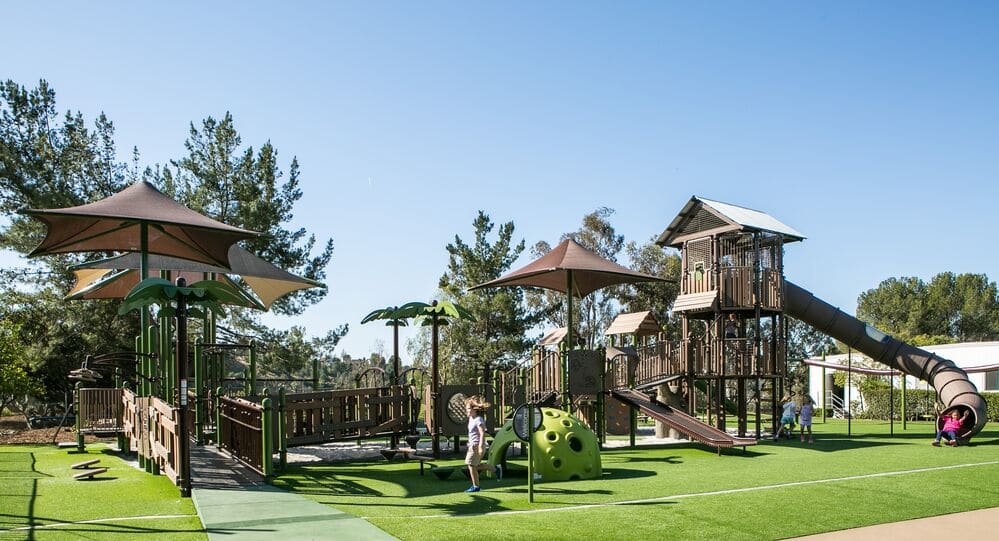
Inclusive design considers the full range of human diversity with respect to ability, language, culture, gender, age and other forms of human difference. Universal design is the design of products and environments to be usable by all people, to the greatest extent possible, without the need for adaptation or specialized design. Accessibility is implied within these design theories but has its own framework as set out by the ADA (Americans with Disabilities Act). For these design methods to work, it is critical that designers obtain the expertise of excluded communities to give insight into a diversity of ways to participate in an experience.
“Design with us, not for us”
The design itself should promote different types of engagement. When adapted to play spaces, these design methods consider how people with differing abilities will:
- Get to the park – Can they take public transportation and is the bus stop close to the playground? Do they need a car to get there? What is the parking situation?
- Access the playground – how far is it from a parking spot to the playground? Are there paths?
- Access amenities – are there washrooms, drinking fountains, shady places to take a break close by?
- Interact with the play space via different surfacing types and access points.
- Interact with the individual playground components and equipment.
Children discover and learn through play and a well-designed playground can facilitate social, emotional and physical learning.
Unfortunately, there are still many playgrounds that exclude children who have disabilities. There may be an access issue for kids who use wheelchairs or other mobility devices. A play space may not provide equipment that offers a sensory experience to kids with autism or sensory processing disorders. There may not be quiet areas where kids can be alone or just hang out with others to take a break from active play.
School communities are advocating for more inclusive playgrounds to match their inclusion policies for education, and governments have responded with funding opportunities.
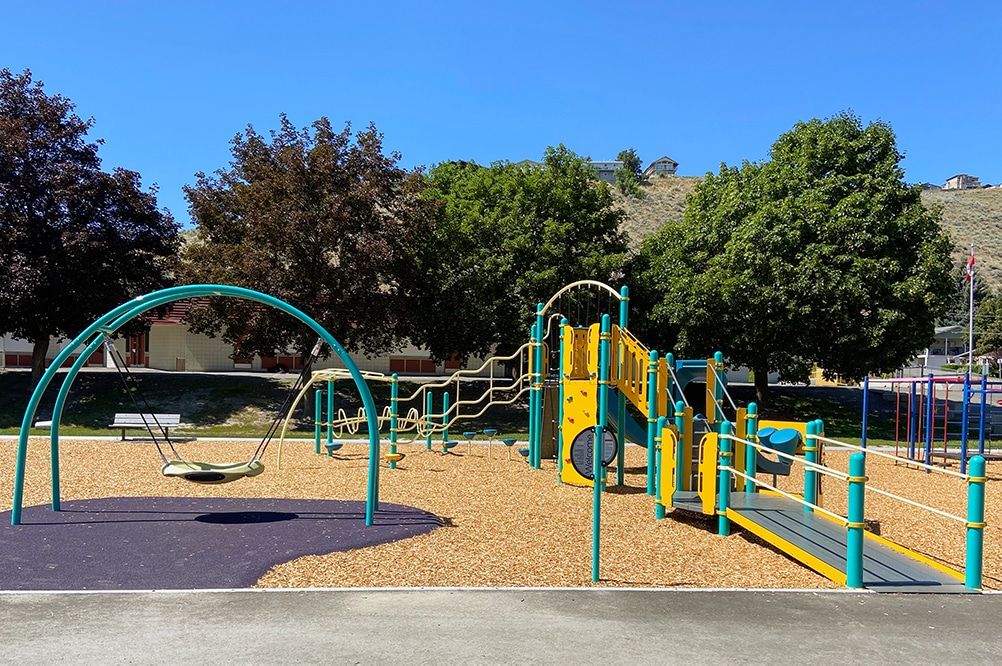
Alberta Education provides grant funding of up to $250,000 per school to support the construction of a playground for eligible projects. Communities can apply for the Community Facility Enhancement Program grant to upgrade or replace an existing playground. Currently, schools would need to choose between a standard and a universally accessible playground design when they apply.
In 2018 the Government of British Columbia (BC) released their PEP (Playground Equipment Program) grant for school districts to purchase new or replacement playgrounds. At that time, school districts had a choice to get a standard or universally accessible playground. In a letter from the BCEd Access Society to the Minister of Education in 2019, BCEd Access stated “in 2019 accessible playgrounds should be the norm and not the exception.” The government updated the PEP guidelines for 2020/21 in the Capital Programs for K-Gr. 12, allowing for the purchase and install of playground equipment that is universal in design, and in compliance with accessibility measures as defined through the Canadian Standards Association (CSA). These guidelines follow the ADA guidelines for accessibility. It also added that the playground must include appropriate ground cover for fall protection, improved access, and increased mobility.
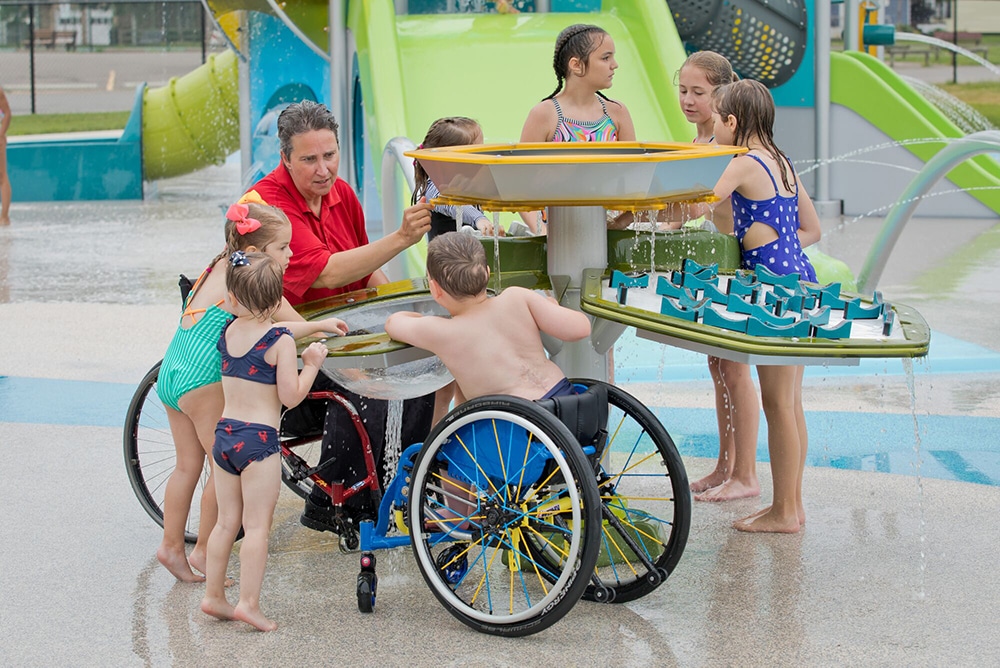
Landscape Structures Inc. (LSI), the playground manufacturer that Habitat Systems represents in Western Canada, is an industry leader in the design of inclusive playgrounds. They have a diverse team of consultants who make up their Inclusive Play Advisory Board where each Board member contributes their unique perspective to the design of equipment and play spaces. The Board adopts the Seven Principles of Universal Design to influence their design practice. These principles are a guide for anyone interested in, or advocating for, more inclusive environments:
- Equitable Use. The design is useful to people with diverse abilities.
- Flexibility in Use. The design accommodates a wide range of individual preferences and abilities.
- Simple and Intuitive Use. Use of the design is to easy to understand regardless of the user’s experience, knowledge, language skills, current concentration level.
- Perceptible Information. The design communicates necessary information effectively to the user regardless of ambient conditions or the user’s sensory abilities.
- Tolerance for Error. The design minimizes hazards and the adverse consequences of accidental or unintended actions.
- Low Physical Effort. The design can be used efficiently and comfortably.
- Size and Space for Approach and Use. Appropriate size and space are provided for approach, reach, manipulation and use regardless of user’s body size, posture or mobility.
The next time you visit a playground, you can check it against these principles to see how inclusive it is.
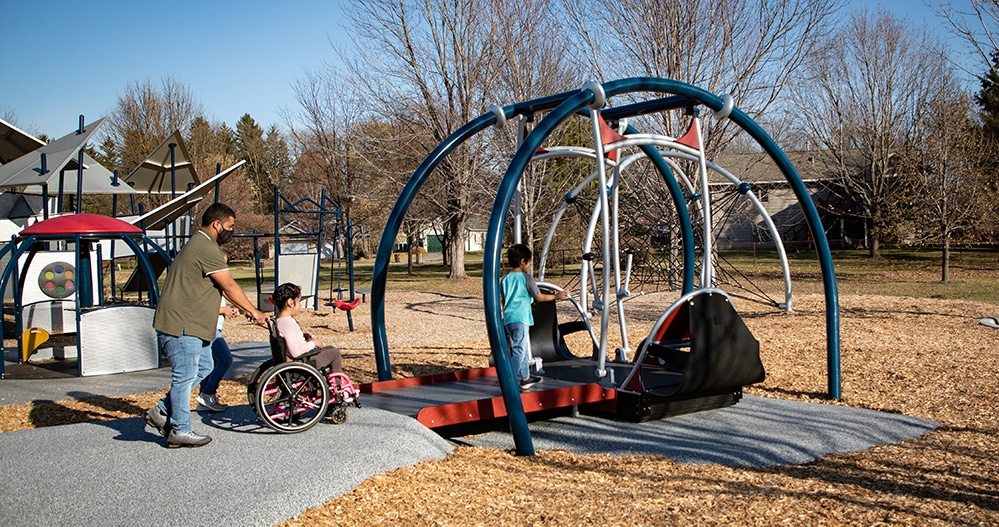
Landscape Structures was led by these principles in the design of the We-Go-Swing, the exciting new addition to their inclusive We-line of playground equipment (which includes the We-Saw and the We-Go-Round). We can examine how each of these principles has been applied:
- Equitable Use: The design works for people in wheelchairs as well as those who use walkers. They can leave their walker on the entry deck and have lots of options for support while getting seated with the posts and bars.
- Flexibility in Use: Multiple users with different abilities can have fun on it together at the same time. They can make it move in a variety of ways, for example, standing and shifting their weight or sitting and using the bars.
- Simple and Intuitive Use: The design itself is welcoming and easy to understand, with an entry deck, a space for a wheelchair and space for sitting.
- Perceptible Information: The design looks like a swing. The bars used for making it move are obvious and intuitive to use.
- Tolerance for Error: The We-Go-Swing is ADA compliant and also compliant with CSA specifications.
- Low Physical Effort: Young children to older adults can set the swing in motion. Bars lower easily in front of the seated users and the swing starts moving when they apply pressure to the bars.
- Size and Space for Approach and Use: The swing has the space to accommodate wheelchairs and multiple users.
The We-Go-Swing™ is a first of its kind, inclusive and universal swing. It is a revolutionary step forward in inclusive play experiences and can be installed in the midst of playground activity, and not segregated, fenced, or locked. Designed to be integrated into the playground setting, this swing lets kids of all abilities play together and engage in, and experience, the thrill of swinging.
The little boy in the following promotional video for LSI’s We-Go-Swing perfectly captures the essence of inclusive design when he says, “even any person who DOESN’T have a wheelchair can go on it.”
Contact us today to schedule an inclusive design session with one of our expert consultations and see how you can create a safe place to play for everyone.
